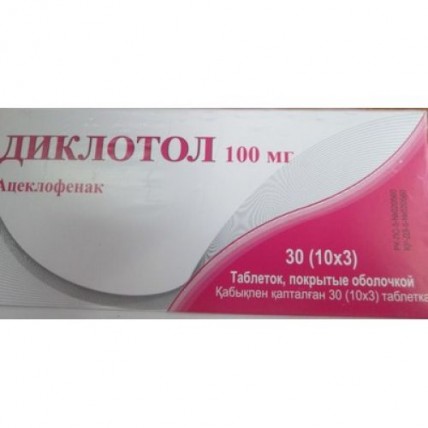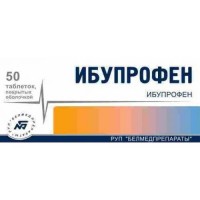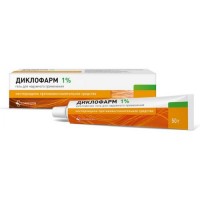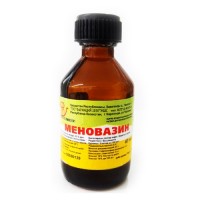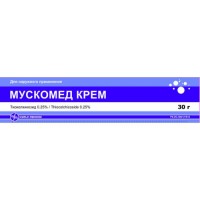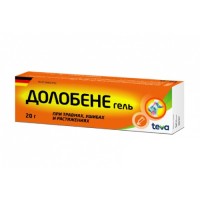Diklotol 30s 100 mg coated tablets
- $15.20
Trade name
of DIKLOTOL
the International unlicensed
name Atseklofenak Lekarstvennaya
the Tablet form, coated 100 mg
Structure
One tablet contains
active agent: atseklofenak - 100 mg,
excipients: microcrystalline cellulose, sodium of a kroskarmelloz, silicon dioxide colloidal anhydrous, stearic acid,
structure of a cover: Opadry-YS-1-7027 white (Opadry-YS-1-7027 white: hydroksipropilmetiltsellyuloza, titan dioxide (E 171), triacetin).
The description
of the Tablet, coated white color, round shape, with a biconvex surface.
Pharmacotherapeutic group
Anti-inflammatory and antirheumatic drugs. Non-steroidal anti-inflammatory drugs. Acetic acid derivatives. Atseklofenak.
ATX M01A B16 code.
The pharmacological
Pharmacokinetics Later properties of oral administration atseklofenak it is quickly soaked up, its bioavailability is nearly 100%. The peak of concentration in plasma is reached in 1.25-3 h after reception. Time of achievement of the maximum concentration (Tmax) slows down at a concomitant use of food while it does not influence extent of absorption.
Distribution. Atseklofenak is highly connected with proteins of plasma (& gt, 99.7%). Atseklofenak gets into synovial fluid where concentration reaches about 60% of concentration in plasma. The volume of distribution is about 30 l.
Removal. Average elimination half-life makes 4-4.3 hours. The clearance is in 5 liters an hour. About two thirds of the accepted dose are removed with urine, mainly in the form of the conjugated hydroxymetabolites. Only 1% of a single oral dose is removed in not changed look. Atseklofenak is probably metabolized by means of CYP2C9 to the main metabolite 4-ON-atseklofenaka which clinical action is insignificant. Diclofenac and 4-IT-diclofenac were found among many metabolites.
Characteristics on patients. At elderly patients changes of pharmacokinetics of an atseklofenak are not revealed. At patients with an abnormal liver function slower removal of an atseklofenak after reception of a single dose was noted. In researches with multiple dose at the use of 100 mg daily, the difference in pharmacokinetic parameters between patients with cirrhosis easy and moderately severe and healthy patients was not. At patients with easy or average degree of a renal failure, clinically significant differences in pharmacokinetics after reception of a single dose it was not observed.
The pharmacodynamics
Atseklofenak is the non-steroidal anti-inflammatory drug having anti-inflammatory and analgesic effect. The mechanism of action is connected with inhibition of synthesis of prostaglandins.
Affects pathogenesis of inflammation, developing of pain and fever. In rheumatic diseases the anti-inflammatory and analgeziruyushchy action of an atseklofenak promotes considerable reduction of severity of pain, morning constraint, a swelling of joints that improves a functional condition of the patient.
Indications
- for pain relief and inflammation in an osteoarthritis, a pseudorheumatism and an ankylosing spondylitis
accept the Route of administration and doses of the Tablet Diklotol inside at meal time, washing down with enough water.
A usual dose of 100 mg 2 times a day.
The maximum recommended dose makes 200 mg a day in two steps on 100 mg (one tablet – in the morning, one – in the evening).
In an abnormal liver function - 100 mg/days.
To patients, with renal failures to take with caution.
Duration of a course of treatment is established individually.
The dose decline is not required to elderly patients.
Side effects
the Majority of usually observed by-effects are disturbances from digestive tract. There can be a stomach ulcer, a perforation or bleeding from a GIT sometimes leading to a lethal outcome, especially at elderly patients.
Use of some non-steroidal anti-inflammatory drugs (NPVP), in high doses and at prolonged use can lead to increase in risk of development of arterial trombotichesky disturbances (for example, to a myocardial infarction or a stroke).
Often (& gt, 1/100, & lt, 1/10)
- dizziness
- nausea, dyspepsia, an abdominal pain, diarrhea
- increase in liver enzymes
Infrequently (& gt, 1/1000, & lt, 1/100)
- vomiting, a meteorism, a constipation, ulcerations in an oral cavity, gastritis
- an itching, skin rash, a dieback, dermatitis, a small tortoiseshell
- increase in level of urea and creatinine in blood
is rare (& gt, 1/10000, & lt, 1/1000)
- anemia
- anaphylactic reactions (including shock), a Quincke's disease
- disorders of vision
- arterial hypertension (including complicated)
- heart failure
- short wind
- a melena (including hemorrhagic diarrhea), ulcerations in digestive tract, hemorrhages in digestive tract, gastrointestinal bleedings
Very seldom / separate cases (& lt, 1/10000)
- a granulocytopenia, thrombocytopenia, a neutropenia, hemolytic anemia - a hyperpotassemia
- a depression, unusual dreams, insomnia
- paresthesia, a tremor, drowsiness, a headache, a dysgeusia (food faddism)
- vertigo, a ring in ears
- a cardiopalmus
- a dermahemia, inflows, a vasculitis
- a bronchospasm
- stomatitis
- a hematemesis, stomach ulcer, pancreatitis, deterioration in the course of the disease Krone and ulcer colitis
- hepatitis
- hemorrhagic rash, eczema, heavy skin and mucous reactions (including Stephens-Johnson's syndrome and a toxic epidermal necrolysis)
- a nephrotic syndrome, a renal failure, interstitial nephrite
- hypostasis, increased fatigue, spasms in legs
- increase in level of alkaline phosphatase
- increase in weight
In special cases, were observed serious skin infections and infections of soft tissues at reception of NPVP during a disease of chicken pox.
Contraindications
- hypersensitivity to drug components
- heart failure
- ulcer of stomach or duodenum
- chronic kidney disease
- a serious illness of a liver, a liver failure
- to patients in whom drugs with similar action (for example, acetylsalicelates and other non-steroidal anti-inflammatory drugs) cause attacks of bronchial asthma, a bronchospasm, acute rhinitis or a small tortoiseshell
- pregnancy and the period of a lactation
- children's and teenage age up to 18 years
Medicinal interactions
Metabolism of an atseklofenak happens by means of P450 2C9 cytochrome. The researches in vitro indicate what atseklofenak can suppress this enzyme. Therefore, there is a probability of pharmacokinetic interaction with Phenytoinum, Cimetidinum, tolbutamide, phenylbutazone, Amiodaronum, Miconazolum and sulfafenazoly. As well as in case of other drugs of the NPVP group, there is a risk of pharmacokinetic interaction with other medicines which are removed due to active secretion by kidneys, such as methotrexate and lithium. Atseklofenak almost completely contacts albumine in plasma therefore
it is necessary to consider the probability of the substituting interactions with other drugs which highly contact proteins.
It is considered that use of NPVP together with a zidovudine can lead to increase in risk of hematologic toxicity, the risk of a hemarthrosis, hematoma amplifies at HIV of the infected patients with hemophilia receiving simultaneous treatment by a zidovudine and an ibuprofen therefore at such combinations it is necessary to show care.
Simultaneous therapy with corticosteroids increases risk of a gastrointestinal ulceration or bleeding.
As researches of pharmacokinetic interaction with participation of an atseklofenak were not conducted, the following information is based on the data obtained concerning other non-steroidal anti-inflammatory drugs:
It is necessary to avoid the following combinations:
NPVS suppress secretion of a methotrexate renal tubules, there can be a decrease in clearance of a methotrexate. Therefore, at therapy by high doses of a methotrexate it is always necessary to avoid prescribing of non-steroidal anti-inflammatory drugs.
Some NPVP lead to braking of clearance of lithium kidneys that leads to increase in serumal concentration of lithium. In case of impossibility of frequent control of level of lithium, it is necessary to avoid this combination.
NPVS suppress aggregation of thrombocytes and injure a mucous membrane of digestive tract that can increase risk of gastrointestinal bleedings at the patients accepting anticoagulants. At impossibility of carrying out careful control, it is necessary to avoid purpose of an atseklofenak in a combination with oral anticoagulants of group of coumarin, tiklopidiny, trombolitika and heparin.
The following combinations can demand dose adjustment and respect for care at use:
Probability of interaction between NPVS and a methotrexate should be considered also at use of low doses of a methotrexate, especially at patients with impaired renal function. In need of use of combination therapy it is necessary to carry out monitoring of function of kidneys.
It is necessary to be careful at use of a methotrexate with NPVS within 24 hours as concentration of a methotrexate can increase that can lead to increase in toxicity of drug.
It is considered that use of NPVP together with cyclosporine or takrolimusy can lead to increase in risk of nephrotoxicity in connection with decrease in synthesis of prostacyclin in kidneys. Therefore, at combination therapy the control of function of kidneys is necessary.
Simultaneous therapy by acetylsalicylic acid and non-steroidal anti-inflammatory drugs can lead to increase in frequency of side effects therefore at such combinations it is necessary to show care.
Non-steroidal anti-inflammatory drugs can reduce diuretic effect of furosemide, a bumetanid and antihypertensive effect of tiazid.
Simultaneous use of kaliysberegayushchy diuretics can lead to increase in potassium concentration, therefore, control of level of potassium in serum is necessary. NPVS can also reduce effect of some hypotensive medicines.
APF inhibitors or antagonists to a type angiotensin II receptor in combination with NPVP can lead to a renal failure. The risk of an acute renal failure, as a rule, of reversible, amplifies at separate categories of patients with impaired renal function, for example, at elderly or at patients with dehydration. Therefore, at use of NPVP in such combination it is necessary to show care, patients have to receive enough liquid, control of function of kidneys is recommended.
Atseklofenak at simultaneous use with bendrofluazidy did not lead to change of arterial blood pressure, however it is impossible to exclude interaction of an atseklofenak with other antihypertensive drugs, for example, beta-blockers.
Other possible interactions
It is necessary to consider the possibility of correction of a dosage of drugs which can lead to a hypoglycemia.
Special instructions
Undesirable reactions can be minimized, using a minimal effective dose during the minimum period necessary for monitoring symptoms.
Reactions it is from outside warm - vascular and cerebrovascular systems.
Appropriate control and consultation as at therapy of NPVP the delay of liquid and hypostases were observed is necessary for patients with arterial hypertension and/or slight or moderate chronic heart failure.
Clinical trials and epidemiological data demonstrate that use of some NPVS (especially in high doses and at prolonged use) can lead to small increase in risk of arterial trombotichesky reactions (for example, a myocardial infarction or a stroke). There are no sufficient data for an exception of similar risk concerning an atseklofenak.
At patients with an uncontrollable hypertension, the chronic heart failure confirmed with coronary heart disease, a disease of peripheral arteries and/or a stroke atseklofenak it is possible to apply only after the careful analysis of a condition of the patient. Also it is necessary to estimate attentively a possibility of more prolonged use of drug at patients with risk factors of a stroke (for example, hypertensia, a lipidemia, diabetes, smoking).
At patients with diseases zheludochno - an intestinal path, ulcer colitis, Crohn's disease, hard currency, a porphyria, atseklofenak it is necessary to apply with care and under careful medical control.
At patients with a slight or moderate abnormal liver function or kidneys and also at patients with other states which lead to a liquid delay it is necessary to take precautionary measures. At such patients the use of NPVP can lead to depression of function of kidneys and a delay of liquid. Also it is necessary to use with care drug at patients to whom therapy by diuretics or that which is in risk group in terms of a hypovolemia is carried out.
It is necessary to approach with care therapy of the elderly patients more inclined to side reactions. Consequences at such patients, for example, gastrointestinal bleedings and/or perforation, often are heavier and can occur without preliminary symptoms and at the uncharged anamnesis at any time during therapy. At patients of advanced age the probability of a renal failure, a liver, heart and vessels is higher.
For all patients who accept NPVP for a long time the observation as a precautionary measure is necessary (for example, regular tracking indicators of blood, function of kidneys and a liver).
Due to the disturbance of fertility it is necessary to estimate attentively a possibility of more prolonged use of drug at women who have problems with conception.
Features of influence of medicine on ability to run the vehicle or potentially dangerous mechanisms
to Patients who run vehicles work with machines and mechanisms, it is necessary to take into account possible undesirable effects from nervous system (dizziness, drowsiness, confusion of consciousness, a visual disturbance and hearing, an incoordination).
Overdose
Symptoms: nausea, vomiting, stomach ache, dizziness, drowsiness and headache.
Treatment: gastric lavage, activated carbon.
Symptomatic therapy. There is no specific antidote.
Forms of release and packing
On 10 tablets in blister strip packaging from aluminum foil.
On 1, 3 or 10 blister strip packagings together with the instruction for medical use in the state and Russian languages place in cardboard box No. 10, No. 30 (103) or No. 100 (1010).
On 14 tablets in blister strip packaging from aluminum foil.
On the 2nd blister strip packaging together with the instruction for medical use in the state and Russian languages place in cardboard box No. 28 (142).
To Store storage conditions in the dry, protected from light place, at a temperature not above
25ºС.
To store out of children's reach!
3 years
not to use a period of storage after the termination of the expiration date specified on packing!
To Develop prescription status According to the prescription
of DIKLOTOL
the International unlicensed
name Atseklofenak Lekarstvennaya
the Tablet form, coated 100 mg
Structure
One tablet contains
active agent: atseklofenak - 100 mg,
excipients: microcrystalline cellulose, sodium of a kroskarmelloz, silicon dioxide colloidal anhydrous, stearic acid,
structure of a cover: Opadry-YS-1-7027 white (Opadry-YS-1-7027 white: hydroksipropilmetiltsellyuloza, titan dioxide (E 171), triacetin).
The description
of the Tablet, coated white color, round shape, with a biconvex surface.
Pharmacotherapeutic group
Anti-inflammatory and antirheumatic drugs. Non-steroidal anti-inflammatory drugs. Acetic acid derivatives. Atseklofenak.
ATX M01A B16 code.
The pharmacological
Pharmacokinetics Later properties of oral administration atseklofenak it is quickly soaked up, its bioavailability is nearly 100%. The peak of concentration in plasma is reached in 1.25-3 h after reception. Time of achievement of the maximum concentration (Tmax) slows down at a concomitant use of food while it does not influence extent of absorption.
Distribution. Atseklofenak is highly connected with proteins of plasma (& gt, 99.7%). Atseklofenak gets into synovial fluid where concentration reaches about 60% of concentration in plasma. The volume of distribution is about 30 l.
Removal. Average elimination half-life makes 4-4.3 hours. The clearance is in 5 liters an hour. About two thirds of the accepted dose are removed with urine, mainly in the form of the conjugated hydroxymetabolites. Only 1% of a single oral dose is removed in not changed look. Atseklofenak is probably metabolized by means of CYP2C9 to the main metabolite 4-ON-atseklofenaka which clinical action is insignificant. Diclofenac and 4-IT-diclofenac were found among many metabolites.
Characteristics on patients. At elderly patients changes of pharmacokinetics of an atseklofenak are not revealed. At patients with an abnormal liver function slower removal of an atseklofenak after reception of a single dose was noted. In researches with multiple dose at the use of 100 mg daily, the difference in pharmacokinetic parameters between patients with cirrhosis easy and moderately severe and healthy patients was not. At patients with easy or average degree of a renal failure, clinically significant differences in pharmacokinetics after reception of a single dose it was not observed.
The pharmacodynamics
Atseklofenak is the non-steroidal anti-inflammatory drug having anti-inflammatory and analgesic effect. The mechanism of action is connected with inhibition of synthesis of prostaglandins.
Affects pathogenesis of inflammation, developing of pain and fever. In rheumatic diseases the anti-inflammatory and analgeziruyushchy action of an atseklofenak promotes considerable reduction of severity of pain, morning constraint, a swelling of joints that improves a functional condition of the patient.
Indications
- for pain relief and inflammation in an osteoarthritis, a pseudorheumatism and an ankylosing spondylitis
accept the Route of administration and doses of the Tablet Diklotol inside at meal time, washing down with enough water.
A usual dose of 100 mg 2 times a day.
The maximum recommended dose makes 200 mg a day in two steps on 100 mg (one tablet – in the morning, one – in the evening).
In an abnormal liver function - 100 mg/days.
To patients, with renal failures to take with caution.
Duration of a course of treatment is established individually.
The dose decline is not required to elderly patients.
Side effects
the Majority of usually observed by-effects are disturbances from digestive tract. There can be a stomach ulcer, a perforation or bleeding from a GIT sometimes leading to a lethal outcome, especially at elderly patients.
Use of some non-steroidal anti-inflammatory drugs (NPVP), in high doses and at prolonged use can lead to increase in risk of development of arterial trombotichesky disturbances (for example, to a myocardial infarction or a stroke).
Often (& gt, 1/100, & lt, 1/10)
- dizziness
- nausea, dyspepsia, an abdominal pain, diarrhea
- increase in liver enzymes
Infrequently (& gt, 1/1000, & lt, 1/100)
- vomiting, a meteorism, a constipation, ulcerations in an oral cavity, gastritis
- an itching, skin rash, a dieback, dermatitis, a small tortoiseshell
- increase in level of urea and creatinine in blood
is rare (& gt, 1/10000, & lt, 1/1000)
- anemia
- anaphylactic reactions (including shock), a Quincke's disease
- disorders of vision
- arterial hypertension (including complicated)
- heart failure
- short wind
- a melena (including hemorrhagic diarrhea), ulcerations in digestive tract, hemorrhages in digestive tract, gastrointestinal bleedings
Very seldom / separate cases (& lt, 1/10000)
- a granulocytopenia, thrombocytopenia, a neutropenia, hemolytic anemia - a hyperpotassemia
- a depression, unusual dreams, insomnia
- paresthesia, a tremor, drowsiness, a headache, a dysgeusia (food faddism)
- vertigo, a ring in ears
- a cardiopalmus
- a dermahemia, inflows, a vasculitis
- a bronchospasm
- stomatitis
- a hematemesis, stomach ulcer, pancreatitis, deterioration in the course of the disease Krone and ulcer colitis
- hepatitis
- hemorrhagic rash, eczema, heavy skin and mucous reactions (including Stephens-Johnson's syndrome and a toxic epidermal necrolysis)
- a nephrotic syndrome, a renal failure, interstitial nephrite
- hypostasis, increased fatigue, spasms in legs
- increase in level of alkaline phosphatase
- increase in weight
In special cases, were observed serious skin infections and infections of soft tissues at reception of NPVP during a disease of chicken pox.
Contraindications
- hypersensitivity to drug components
- heart failure
- ulcer of stomach or duodenum
- chronic kidney disease
- a serious illness of a liver, a liver failure
- to patients in whom drugs with similar action (for example, acetylsalicelates and other non-steroidal anti-inflammatory drugs) cause attacks of bronchial asthma, a bronchospasm, acute rhinitis or a small tortoiseshell
- pregnancy and the period of a lactation
- children's and teenage age up to 18 years
Medicinal interactions
Metabolism of an atseklofenak happens by means of P450 2C9 cytochrome. The researches in vitro indicate what atseklofenak can suppress this enzyme. Therefore, there is a probability of pharmacokinetic interaction with Phenytoinum, Cimetidinum, tolbutamide, phenylbutazone, Amiodaronum, Miconazolum and sulfafenazoly. As well as in case of other drugs of the NPVP group, there is a risk of pharmacokinetic interaction with other medicines which are removed due to active secretion by kidneys, such as methotrexate and lithium. Atseklofenak almost completely contacts albumine in plasma therefore
it is necessary to consider the probability of the substituting interactions with other drugs which highly contact proteins.
It is considered that use of NPVP together with a zidovudine can lead to increase in risk of hematologic toxicity, the risk of a hemarthrosis, hematoma amplifies at HIV of the infected patients with hemophilia receiving simultaneous treatment by a zidovudine and an ibuprofen therefore at such combinations it is necessary to show care.
Simultaneous therapy with corticosteroids increases risk of a gastrointestinal ulceration or bleeding.
As researches of pharmacokinetic interaction with participation of an atseklofenak were not conducted, the following information is based on the data obtained concerning other non-steroidal anti-inflammatory drugs:
It is necessary to avoid the following combinations:
NPVS suppress secretion of a methotrexate renal tubules, there can be a decrease in clearance of a methotrexate. Therefore, at therapy by high doses of a methotrexate it is always necessary to avoid prescribing of non-steroidal anti-inflammatory drugs.
Some NPVP lead to braking of clearance of lithium kidneys that leads to increase in serumal concentration of lithium. In case of impossibility of frequent control of level of lithium, it is necessary to avoid this combination.
NPVS suppress aggregation of thrombocytes and injure a mucous membrane of digestive tract that can increase risk of gastrointestinal bleedings at the patients accepting anticoagulants. At impossibility of carrying out careful control, it is necessary to avoid purpose of an atseklofenak in a combination with oral anticoagulants of group of coumarin, tiklopidiny, trombolitika and heparin.
The following combinations can demand dose adjustment and respect for care at use:
Probability of interaction between NPVS and a methotrexate should be considered also at use of low doses of a methotrexate, especially at patients with impaired renal function. In need of use of combination therapy it is necessary to carry out monitoring of function of kidneys.
It is necessary to be careful at use of a methotrexate with NPVS within 24 hours as concentration of a methotrexate can increase that can lead to increase in toxicity of drug.
It is considered that use of NPVP together with cyclosporine or takrolimusy can lead to increase in risk of nephrotoxicity in connection with decrease in synthesis of prostacyclin in kidneys. Therefore, at combination therapy the control of function of kidneys is necessary.
Simultaneous therapy by acetylsalicylic acid and non-steroidal anti-inflammatory drugs can lead to increase in frequency of side effects therefore at such combinations it is necessary to show care.
Non-steroidal anti-inflammatory drugs can reduce diuretic effect of furosemide, a bumetanid and antihypertensive effect of tiazid.
Simultaneous use of kaliysberegayushchy diuretics can lead to increase in potassium concentration, therefore, control of level of potassium in serum is necessary. NPVS can also reduce effect of some hypotensive medicines.
APF inhibitors or antagonists to a type angiotensin II receptor in combination with NPVP can lead to a renal failure. The risk of an acute renal failure, as a rule, of reversible, amplifies at separate categories of patients with impaired renal function, for example, at elderly or at patients with dehydration. Therefore, at use of NPVP in such combination it is necessary to show care, patients have to receive enough liquid, control of function of kidneys is recommended.
Atseklofenak at simultaneous use with bendrofluazidy did not lead to change of arterial blood pressure, however it is impossible to exclude interaction of an atseklofenak with other antihypertensive drugs, for example, beta-blockers.
Other possible interactions
It is necessary to consider the possibility of correction of a dosage of drugs which can lead to a hypoglycemia.
Special instructions
Undesirable reactions can be minimized, using a minimal effective dose during the minimum period necessary for monitoring symptoms.
Reactions it is from outside warm - vascular and cerebrovascular systems.
Appropriate control and consultation as at therapy of NPVP the delay of liquid and hypostases were observed is necessary for patients with arterial hypertension and/or slight or moderate chronic heart failure.
Clinical trials and epidemiological data demonstrate that use of some NPVS (especially in high doses and at prolonged use) can lead to small increase in risk of arterial trombotichesky reactions (for example, a myocardial infarction or a stroke). There are no sufficient data for an exception of similar risk concerning an atseklofenak.
At patients with an uncontrollable hypertension, the chronic heart failure confirmed with coronary heart disease, a disease of peripheral arteries and/or a stroke atseklofenak it is possible to apply only after the careful analysis of a condition of the patient. Also it is necessary to estimate attentively a possibility of more prolonged use of drug at patients with risk factors of a stroke (for example, hypertensia, a lipidemia, diabetes, smoking).
At patients with diseases zheludochno - an intestinal path, ulcer colitis, Crohn's disease, hard currency, a porphyria, atseklofenak it is necessary to apply with care and under careful medical control.
At patients with a slight or moderate abnormal liver function or kidneys and also at patients with other states which lead to a liquid delay it is necessary to take precautionary measures. At such patients the use of NPVP can lead to depression of function of kidneys and a delay of liquid. Also it is necessary to use with care drug at patients to whom therapy by diuretics or that which is in risk group in terms of a hypovolemia is carried out.
It is necessary to approach with care therapy of the elderly patients more inclined to side reactions. Consequences at such patients, for example, gastrointestinal bleedings and/or perforation, often are heavier and can occur without preliminary symptoms and at the uncharged anamnesis at any time during therapy. At patients of advanced age the probability of a renal failure, a liver, heart and vessels is higher.
For all patients who accept NPVP for a long time the observation as a precautionary measure is necessary (for example, regular tracking indicators of blood, function of kidneys and a liver).
Due to the disturbance of fertility it is necessary to estimate attentively a possibility of more prolonged use of drug at women who have problems with conception.
Features of influence of medicine on ability to run the vehicle or potentially dangerous mechanisms
to Patients who run vehicles work with machines and mechanisms, it is necessary to take into account possible undesirable effects from nervous system (dizziness, drowsiness, confusion of consciousness, a visual disturbance and hearing, an incoordination).
Overdose
Symptoms: nausea, vomiting, stomach ache, dizziness, drowsiness and headache.
Treatment: gastric lavage, activated carbon.
Symptomatic therapy. There is no specific antidote.
Forms of release and packing
On 10 tablets in blister strip packaging from aluminum foil.
On 1, 3 or 10 blister strip packagings together with the instruction for medical use in the state and Russian languages place in cardboard box No. 10, No. 30 (103) or No. 100 (1010).
On 14 tablets in blister strip packaging from aluminum foil.
On the 2nd blister strip packaging together with the instruction for medical use in the state and Russian languages place in cardboard box No. 28 (142).
To Store storage conditions in the dry, protected from light place, at a temperature not above
25ºС.
To store out of children's reach!
3 years
not to use a period of storage after the termination of the expiration date specified on packing!
To Develop prescription status According to the prescription
